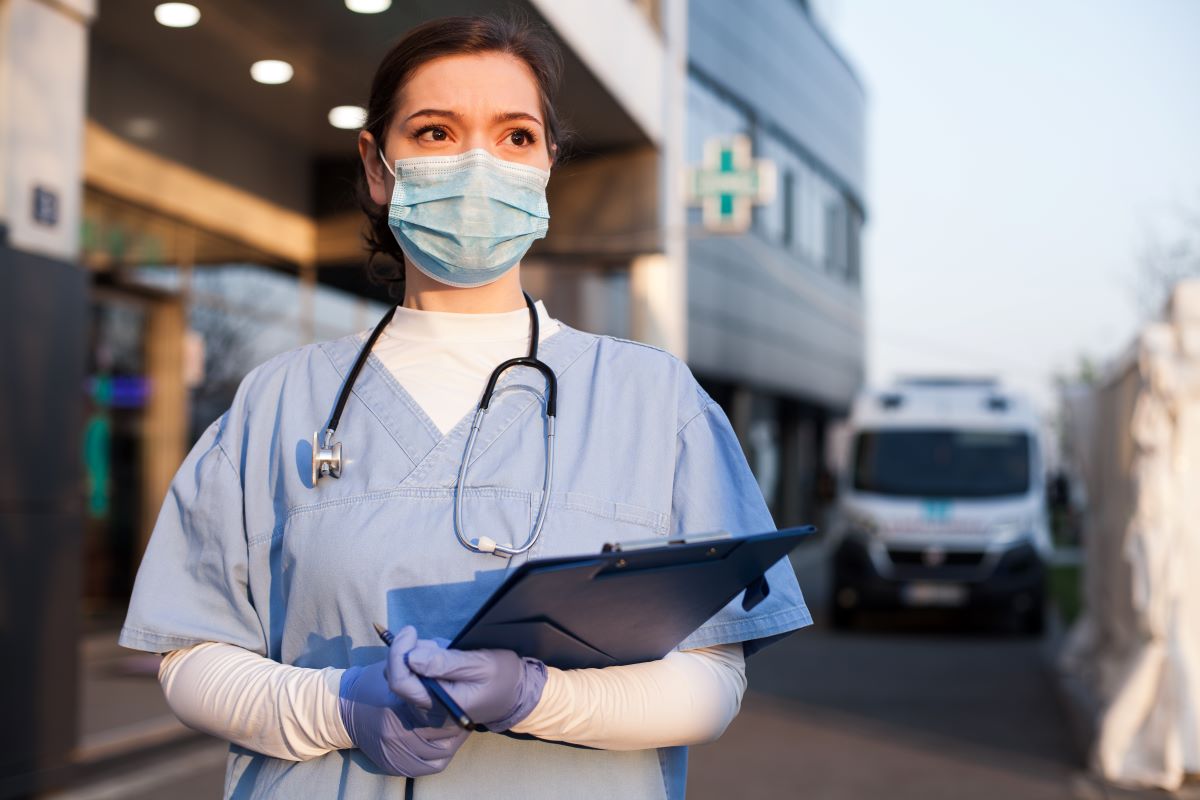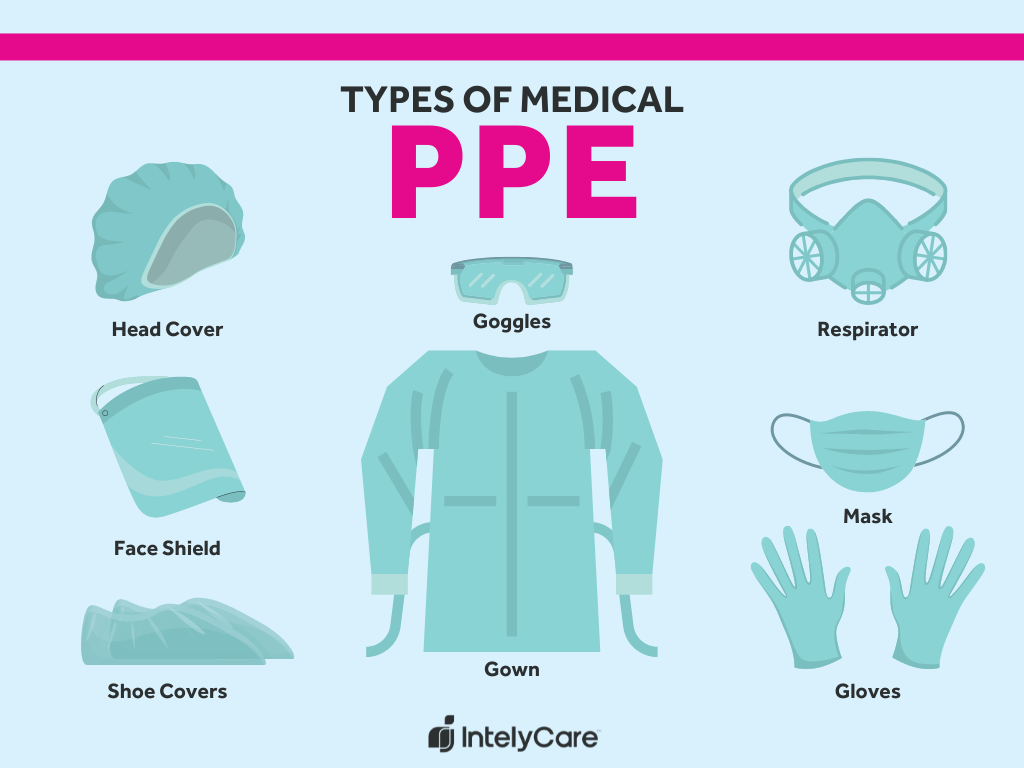PPE: Examples and Guide for Proper Use

Picture a doctor or nurse going into an operating room to perform surgery. They are covered head to toe with special clothing and protective items called PPE (personal protective equipment) to keep them safe from contacting and transmitting germs and infectious material they will encounter when treating a patient. PPE examples include masks and scrubs and other items that provide protection from head to toe.
That’s a far cry from medical and surgical norms just a couple of centuries ago. In 1847, German doctor Ignac Semmelweis was driven out of the medical profession when he introduced the idea that hand washing prevented spreading illness. It took 20 years for Louis Pasteur and Joseph Lister’s germ theory of disease and the concept of antisepsis to be accepted. This led to healthcare professionals washing their hands and wearing PPE when treating patients.
What Is PPE?
PPE examples include garments and equipment that medical professionals use to stay safe from illnesses when they treat patients. To prevent disease from being spread from one person to another, nurses and doctors dispose of PPE and use new PPE before they visit the next patient.
The U.S. Food and Drug Administration regulates the standards for PPE quality. The U.S. Centers for Disease Control and Prevention (CDC) recommends how and when healthcare professionals should use PPE.
The CDC also defines four types of precautions based on the type of infection or pathogen the patient may have, and what PPE is needed for each type. Precaution categories are:
- Direct or indirect patient contact
- Bloodborne products
- Droplet
- Airborne

What Are Examples of PPE and What Is PPE Protocol?
Examples of PPE include gloves, gowns, shoe and head covers, masks, respirators, other face and eye protection. Let’s look at each of these examples, how healthcare professionals use them, and why they are essential.
Gloves
Gloves are an example of PPE that we see most often. Healthcare workers must wear gloves when handling infectious materials or potentially contaminated surfaces. You must also wear gloves when you examine a patient, or touch a patient’s immediate environment and belongings. Medical-grade gloves come in vinyl, latex, or nitrile.
Healthcare workers wear them when there is a likelihood of coming in contact with a patient’s blood, body fluids, non-intact skin, mucous membranes, secretions, and excretions other than sweat.
You should remove gloves when they are visibly soiled, torn, or punctured, when you move from one patient to another, and before you touch non-contaminated items and surfaces. Gloves provide protection but do not replace the need for thorough handwashing. When you doff (remove) gloves, use safety protocol for glove removal, dispose of them in the proper container, and wash your hands.
Gowns
Gowns are PPE examples of protection used throughout a healthcare setting. They protect your exposed skin and clothing from contamination when you work around potentially infectious material (the same materials described for gloves). Doctors and nurses wear gowns when procedures may produce splashes or sprays of blood, body fluids, secretions, and excretions.
It’s important that your gown fully covers your torso, fits close to the body, and covers your arms and wrists. Check your gown for any holes or rips, and make sure there are no gaps in the seams.
Gowns come in various types. You must throw away disposable versions after each use. Reusable gowns require laundering and must be placed in a marked bin when you remove them.
Regardless of the type of gown, follow CDC guidelines for gown removal. Gowns also can be fluid resistant and non-fluid-resistant. Of course, you always want to don (put on) a clean gown. But you can also wear a sterile gown (also known as a surgical gown) that provides increased coverage and protection.
Shoe and Head Covers
Protective items worn over your shoes and head are PPE examples that both healthcare professionals and patients wear. Shoe covers protect a medical professional’s shoes from exposure to airborne organisms or contact with a contaminated environment. Similarly, head covers (bonnets) protect your hair and scalp from spray or airborne exposure contamination.
Masks and Respirators
A surgical mask protects your nose and mouth when there is a possibility of splatter from body fluids, including blood, respiratory secretions, droplets, vomit, urine, or feces. A mask also protects against inhaling and exhaling droplets of these substances.
A respirator filters the air before you breathe to protect you from airborne microorganisms like bacteria and viruses. Respirators come in three main categories. Disposable respirators are the most commonly used mask.
N95 disposable masks are popular PPE examples because they protect both a respirator and a surgical mask. It’s important to ensure that N95 respirators are fitted and worn correctly. Following instructions for how to don, position, adjust, and remove them.
PAPR respirators are the next level of respirators. The Powered Air Purifying Respirator is worn for high-risk aerosol-generating procedures or in areas with potentially high levels of airborne disease.
A PAPR is a battery-operated face protector that covers half or the full face. Attached is a breathing tube, battery-operated blower, and a filter for particulates. You can add a face shield to a half-mask PAPR respirator. Medically certified persons can wear PAPR respirators if an N95 mask does not fit because of facial hair or deformity.
You must have a medical evaluation to ensure you can use a PAPR since it increases breathing resistance, cardiac work, heart rate, and blood pressure. Some people can also experience claustrophobia, anxiety, and hyperventilation when wearing a PAPR. PAPRs must be cleaned and disinfected. Each PAPR manufacturer provides cleaning instructions.
SCBA Respirators are self-contained breathing apparatuses. Emergency responders use SCBAs when they anticipate encountering chemical, biological, radiological, and nuclear (CBRN) environments. Because SCBAs were developed to protect first responders against terrorist attacks, The CDC’s National Institute for Occupational Safety and Health (NIOSH) controls their use.
Other Face and Eye Protection
Face and eye protection includes face shields to protect the skin, eyes, nose, and mouth against splatters. Goggles provide protection just for eyes.
Face shields most commonly are plastic — PET, acetate, or polycarbonate. Their design protects the mucous membranes of your eyes, nose, and mouth from sprays and splashes of body fluid. You can wear a face shield with an N95 respirator. It should cover your face from your forehead to below your chin and wrap around the side of your face.
Goggles protect just your eyes. They should fit snugly over and around your eyes. You can wear goggles made specifically for use with prescriptive lenses. Prescriptive lenses alone are not considered eye protection.
Protect Your Personal Time
One of our favorite PPE examples is Protection of Personal Enjoyment. Put yourself on IntelyCare’s list and set your own work schedule. Check out the future of nursing and start your application today.

